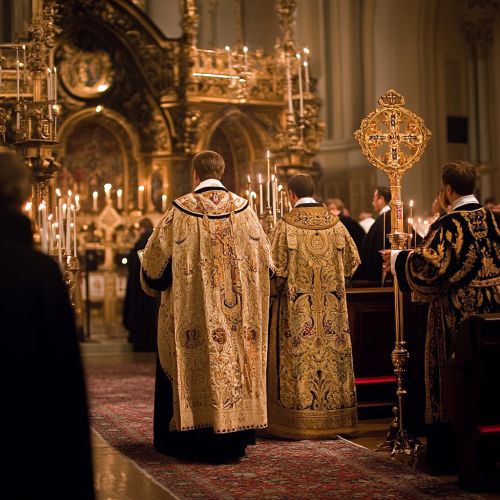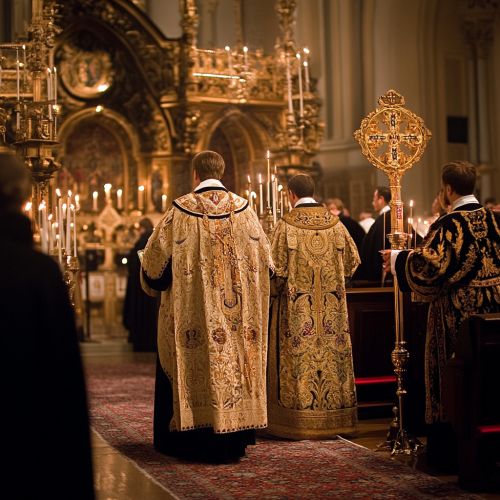High Church
Overview
High Church is a term used within Anglicanism to describe a tradition that emphasizes the continuity of the Church of England with the pre-Reformation Catholic Church. This tradition is characterized by its emphasis on liturgical formality, sacramental theology, and the authority of the episcopate. High Church practices often include the use of elaborate vestments, incense, and other ceremonial elements that are typically associated with Roman Catholic worship.
Historical Context
Origins
The High Church tradition finds its roots in the early 17th century during the reign of King James I. The term "High Church" was initially used pejoratively by Puritans to describe those within the Church of England who resisted Puritan reforms and adhered to more traditional forms of worship and governance. These early High Churchmen were influenced by the writings of theologians such as Richard Hooker, who defended the Elizabethan Settlement and the episcopal structure of the Church.
The Caroline Divines
The High Church tradition was further developed by a group of theologians known as the Caroline Divines during the reigns of Charles I and Charles II. Prominent figures such as Lancelot Andrewes, William Laud, and Jeremy Taylor emphasized the importance of the sacraments, the apostolic succession of bishops, and the beauty of holiness in worship. Their writings and practices laid the groundwork for what would later be known as Anglican High Churchmanship.


The Oxford Movement
The 19th century saw a significant revival of High Church principles through the Oxford Movement. This movement, led by figures such as John Henry Newman, Edward Bouverie Pusey, and John Keble, sought to reassert the Catholic heritage of the Church of England. The Tracts for the Times, a series of publications by the leaders of the movement, argued for the importance of the sacraments, the apostolic succession, and the authority of the Church. The Oxford Movement had a profound impact on Anglican liturgy and theology, leading to a resurgence of High Church practices.
Liturgical Practices
Vestments
High Church liturgy is often marked by the use of elaborate vestments. Clergy may wear chasubles, dalmatics, copes, and other traditional garments that signify their liturgical roles. The use of these vestments is intended to reflect the solemnity and sacredness of the worship service.
Incense and Candles
The use of incense and candles is another hallmark of High Church worship. Incense is often used during the Eucharist, processions, and other solemn occasions to symbolize the prayers of the faithful rising to heaven. Candles are used to signify the presence of Christ and to add to the visual and sensory richness of the liturgy.
Sacramental Theology
High Church theology places a strong emphasis on the sacraments, particularly the Eucharist. High Church Anglicans typically believe in the real presence of Christ in the Eucharist, though they may differ in their understanding of how this presence is manifested. The sacraments are seen as means of grace, essential for the spiritual life of the believer.
Theological Emphases
Apostolic Succession
One of the key theological tenets of the High Church tradition is the belief in apostolic succession. This doctrine holds that the authority of the Church's ministry is derived from the apostles through an unbroken line of bishops. High Church Anglicans argue that this succession is essential for the validity of the sacraments and the unity of the Church.
Authority of the Church
High Church Anglicans place a strong emphasis on the authority of the Church, particularly the episcopate. They believe that the bishops, as successors of the apostles, have a unique authority to govern the Church and to safeguard its doctrine and sacraments. This emphasis on ecclesiastical authority often leads High Church Anglicans to resist innovations in doctrine and practice that are not rooted in the tradition of the Church.
The Beauty of Holiness
The concept of the "beauty of holiness" is central to High Church spirituality. This idea, which can be traced back to the Caroline Divines, holds that the worship of God should be conducted with the utmost reverence and beauty. This is reflected in the use of elaborate liturgy, music, and architecture, all of which are intended to lift the hearts and minds of the faithful to God.
High Church and Anglo-Catholicism
While the terms "High Church" and "Anglo-Catholic" are often used interchangeably, they are not synonymous. High Churchmanship is a broader tradition within Anglicanism that emphasizes liturgical formality and sacramental theology, while Anglo-Catholicism is a specific movement within the High Church tradition that seeks to reassert the Catholic heritage of Anglicanism. Anglo-Catholics often adopt practices and beliefs that are closely aligned with those of the Roman Catholic Church, such as devotion to the Virgin Mary and the saints, the use of the rosary, and the practice of confession.
Modern High Church Practices
Liturgical Renewal
The 20th and 21st centuries have seen a continued interest in liturgical renewal within the High Church tradition. This has included the revision of liturgical texts, the incorporation of contemporary language and music, and a renewed emphasis on the participation of the laity in worship. Despite these changes, High Church Anglicans continue to value the traditional elements of their liturgical heritage.
Ecumenical Relations
High Church Anglicans have often been at the forefront of ecumenical efforts, particularly with the Roman Catholic Church and the Eastern Orthodox Church. These efforts have included dialogues on theological issues, joint worship services, and collaborative social and charitable initiatives. The goal of these efforts is to promote Christian unity while respecting the distinct traditions of each church.
Social and Ethical Issues
High Church Anglicans, like other Christians, are engaged in a wide range of social and ethical issues. These include debates over the ordination of women, the inclusion of LGBTQ+ individuals in the life of the Church, and the Church's response to issues such as poverty, racism, and environmental degradation. High Church Anglicans often approach these issues with a strong sense of tradition and a commitment to the authority of the Church.
